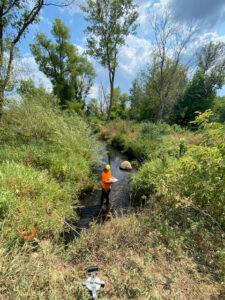Niagara Bottling proposes groundwater-fed bottling plant in Elko New Market
The debate over groundwater protection is playing out in Scott County, Minnesota, as California-based Niagara Bottling seeks to build a $125 million water bottling plant near the headwaters of the Vermillion River. Freshwater is urging decision makers to consider the unique geologic setting and vulnerable resources at stake.
The project would tap into the City of Elko New Market’s municipal water supply, drawing up to 310 million gallons of water annually from the Prairie du Chien-Jordan aquifer. To accommodate this industrial water use, the City has requested an amendment to its current groundwater appropriation permit with the Minnesota DNR, asking to increase the permitted amount from 135 million gallons to 365 million gallons per year.
Residents ask for environmental review
After learning about the proposed bottling plant in October 2022, local resident Janelle Kuznia contacted Freshwater and the Minnesota Center for Environmental Advocacy to learn about the environmental risks and to find out what could be done. “This seems like a poor use of a public resource,” said Kuznia. “One business would be using more water than the entire city.”
A coalition of residents petitioned the Environmental Quality Board for an environmental assessment worksheet (EAW) on the project. The board directed the DNR to determine whether an EAW was needed, and the agency decided in February that it was not. In its decision, the DNR cited a lack of evidence that the project would directly harm the Vermillion River, area wetlands or Kelleher Fen, a nearby calcareous fen that is dependent on groundwater. However, it did say that DNR staff would look closely at any potential surface water connections during the water appropriations permit review for the City of Elko New Market.
Looking regionally and glacially
The situation in Elko New Market illustrates some important concerns regarding Minnesota’s approach to groundwater decision-making. In Groundwater Governance, Well Cobbled?, researchers from Freshwater and the University of Minnesota recommend elevating groundwater sustainability within regional decision-making and planning processes. If regulators look too narrowly at a given project to assess its potential for direct harm, then larger regional concerns about groundwater use may be overlooked.
“All of the communities south of the Minnesota River share the same aquifer. Population is increasing and cones of depression in the aquifer deepening and merging,” said Carrie Jennings, research and policy director at Freshwater. “There is no plan B for the cities too far from the river to use a surface-water source. So we must plan now for just and equitable sharing of this common resource into the future.”
Another concern is whether decisions are being made using the best available science. A key aspect of the Niagara project is its unique glacial setting at the edge of an ice margin where a network of underground tunnels allow groundwater to move laterally in sometimes unpredictable ways.
Without further study of the groundwater connections imparted by these tunnel features, it is difficult to know for sure how an industrial water pumping operation will affect local drinking water wells, along with surface water resources like the Vermillion River.

A sensitive coldwater ecosystem
As one of the last remaining trout streams in the Twin Cities area, the Vermillion River supports a sensitive coldwater ecosystem thanks to the influx of groundwater, which allows it to maintain a fairly steady temperature year-round.
In the summertime, sections of the Vermillion River can approach 73 degrees Fahrenheit, the lethal threshold for brown trout, forcing the fish to seek refuge in deep pools or tributary streams.
Excessive well pumping in the watershed can reduce both the volume and flux (discharge rate) of cool groundwater coming into a stream like the Vermillion. Plus, as surrounding land is developed with impervious surfaces like pavement and rooftops – or drain-tiled for agricultural use – the resulting increase in surface water runoff can dramatically warm the stream when it rains in the summer. And a sustained warming of just a few degrees could mean the end of the Vermillion River’s wild trout population.
Advocating for further study
In order to help both the DNR and the City of Elko New Market make informed decisions on the Niagara project, Freshwater’s Carrie Jennings has brought forward mapping data from the Minnesota Geologic Survey and recommended specific aquifer testing the DNR could perform during its permit review process.
“What is needed is a special kind of pumping test of adequate duration to determine if there is connectivity between aquifers and to test the hypothesis that deep, sand-and-gravel filled valleys connect the bedrock aquifers to surface-water features,” explained Jennings.
Janelle Kuznia and others who live near the proposed site appreciate how Freshwater has stepped up to engage in the process. “Carrie’s been extremely helpful pointing out to both the DNR and to the City Council any scientific information that would help them understand why it’s so important for them to do this multi-aquifer test,” she said. “Freshwater has actually brought most of the scientific evidence to the surface.”
